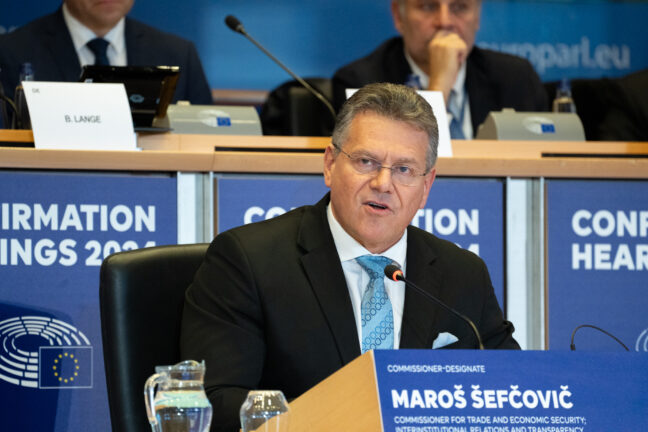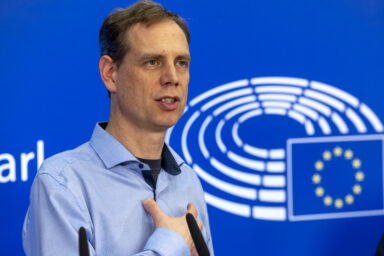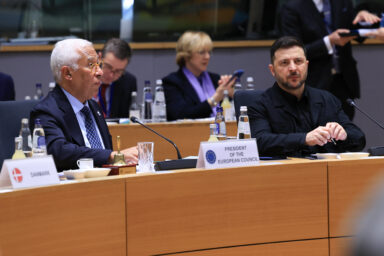The European Trade Commissioner‘s tariff mission to Washington has introduced few certainties to the US-EU trade dispute. The bloc now relies on the unorthodox solution of entrusting the future of the issue to Italian PM Giorgia Meloni on the grounds of her cordial relationship with the US President—while more American tariffs are on the global horizon.
When Maroš Šefčovič, European Commissioner for Trade and Economic Security, travelled to Washington on Monday, he may have harboured cautious optimism about renegotiating some of the United States’ tariffs—threatened, announced, then paused—that characterise current American trade policy.
By Tuesday, those hopes were all but dashed.
According to unnamed European officials cited by the Financial Times, the US informed the EU that certain American tariffs would persist even after bilateral negotiations, offering precious little on how Brussels might mitigate them. Diplomats noted that American negotiators emphasised their commitment to repatriating industries from overseas, a goal they argued necessitated maintaining tariffs at some level. “The US is not ready to reduce tariffs on cars or steel but maybe had flexibility on the reciprocal tariffs—though their baseline would be 10 per cent. So what is there to be flexible on?” said one of the diplomats.
You might be interested
Uncertainty persists
Mr Šefčovič struck a measured tone publicly. “In D.C., met with Secretary @howardlutnick and Ambassador @jamiesongreer for EU-US negotiations, seizing the 90-day window for a mutual solution to unjustified tariffs,” the Slovakian Commisioner posted on X. “The EU remains constructive and ready for a fair deal—including reciprocity through our 0-for-0 tariff offer on industrial goods and the work on non-tariff barriers. Achieving this will require a significant joint effort on both sides.”
The EU has temporarily suspended retaliatory tariffs—crafted in response to US steel and aluminium levies—until 14 July. Yet, as another EU diplomat quoted by Bloomberg, the chaotic policymaking within the Trump administration has muddied the waters not only between genuine strategy and tactical posturing, but also between who is in charge of policy matters and who is off the loop. “They change quite often,” the diplomat said. “It’s also difficult to distinguish who has the power to say something and who says something with no power or influence at all. Keeping the tension, making everything ‘temporary’ has become pretty much a pattern.”
A two way street
Mr Trump has framed these tariffs as tools to rectify trade imbalances with individual partners (treating the EU as a single entity). Notably, the US maintains a services trade surplus with the bloc: in 2023, the EU imported €427bn in services from America while exporting €319bn, yielding a US surplus of €109bn(roughly $118bn). This contrasts sharply with the US goods trade deficit, which stood at $235.6bn in 2024.
The European Commission has urged Washington to articulate its demands explicitly. “We need to hear more from the Americans. We need to have a clearer idea of what their preferred outcomes are in these negotiations,” EU trade spokesman Olof Gill told the media on Tuesday. He reiterated Mr Šefčovič’s proposal for a mutual elimination of all industrial goods tariffs. “The EU is doing its part. Now, it is necessary for the US to define its position. As with every negotiation, this must be a two-way street… with both sides bringing something,” Mr Gill added.
Mr Trump has previously demanded that the EU increase purchases of American liquefied natural gas—a concession Brussels has accepted in principle—while lambasting the bloc for insufficient car imports and erecting “non-tariff barriers”. The EU, for its part, has warned that its retaliatory measures—targeting €21 billion of US goods—would take effect after the 90-day window absent a satisfactory resolution. At the same time, Brussels is concurrently accelerating global trade deals and refining its single market mechanisms to hedge against escalation.
„Inflation Day“
The US trade offensive—alongside Washington’s unfavourable geopolitical repositioning—has shaken European institutions viscerally, eliciting some emotional language from EU officials. Member of the European Parliament Bernd Lange (S&D/DE) responded to the original 20 per cent tariff: “While President Trump might call today ‘Liberation Day’, from an ordinary citizen’s point of view this is ‘Inflation Day’. These unjustified, illegal and disproportionate measures can only lead to further tariff escalation and a downward economic spiral for the US and the world as a whole,“ the Chairman of the Parliament’s International Trade Committee said in a statement on 2 April.
“The EU will respond. We will do so through legal, legitimate, proportionate and decisive measures. As the EU we will consider which of the tools at our disposal are best suited for our response. We are not backing down. We will defend our sovereignty and we will not change legislation that we have shaped democratically and in the interest of EU citizens, even if this displeases some US billionaires,“ Mr Lange said.
Meloni’s turn
Mr Šefčovič’s trip ended took place just hours before Italian PM Giorgia Meloni was scheduled to go to Washington herself on Wednesday in an effort to persuade Trump to take his foot off the tariff pedal. While hopes were slim that Meloni could return with a deal, the Commission and some European countries may value her as a scout “to feel the ground and lay the basis for future negotiations,” said Alberto Rizzi, a policy fellow at the European Council on Foreign Relations told Politico.eu.
“Politics, like life, is built on personal relationships,” said Marco Scurria, an Italian senator from Meloni’s Brothers of Italy party. “It’s better when such a complex negotiation is handled by two people who respect each other and can more easily reach a positive outcome — unlike with von der Leyen,” he was quoted as saying by the same news outlet.
Regardless of these overtures, Mr Trump shows little inclination to relent. On Monday, he instructed federal agencies to investigate imports of semiconductors and pharmaceuticals, a procedural step toward imposing tariffs. The Commerce Department announced probes into whether these imports “threaten to impair US national security”, scrutinising semiconductors, manufacturing equipment, pharmaceuticals, and active drug ingredients.
Next: Chips and drugs
Pharmaceutical giants—including Merck, Eli Lilly, and Johnson & Johnson—would bear the brunt of such measures. Most operate extensive global supply chains, with significant manufacturing bases in Europe. In anticipation, firms have rushed to announce US investments. Swiss-based Novartis recently pledged $23bn over five years, following similar commitments from Eli Lilly and Merck.
Ireland, which enjoys a €47.6 billion trade surplus with the US driven largely by pharmaceuticals, faces acute exposure. The sector’s dominance—fueled by Ireland’s low corporate tax rates and skilled workforce—has drawn Mr Trump’s ire. US drugmakers, including Pfizer, operate nearly two dozen Irish factories that export to America.
Industry surveys reveal widespread anxiety: nearly all 42 companies polled anticipate surging manufacturing costs if EU tariffs materialise, with half warning of disrupted research partnerships or delayed regulatory filings. “Re-onshoring key parts of the biotechnology supply chain to the US and our allies… should be a high priority for both national and economic security,” said John Crowley, president of the Biotechnology Innovation Organisation (BIO). “It will take years, though, for this shift. We need to be mindful of the negative consequences of these proposed tariffs.”
Mr Trump’s protectionist agenda shows no signs of abatement. A Tuesday executive order tasked the Commerce Department with bolstering domestic production of critical minerals—a move ostensibly targeting China but risking collateral damage to (former) allies. Should tariffs follow, analysts fear a global trade war could tip the world economy into recession.











